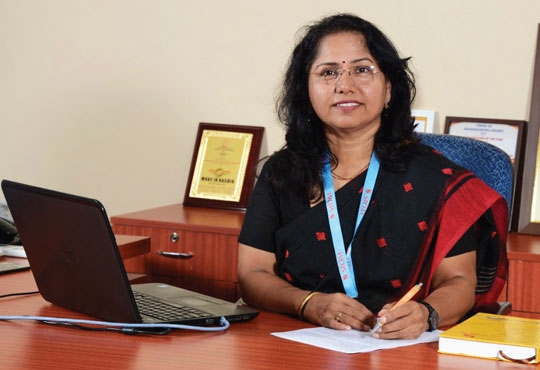
Transformation of Indian Agriculture through IT applications
Mihir Mohanta, GM (SCM & Procurement) & Head SCM, Mother Dairy Fruit & Vegetable | Thursday, 19 October 2017, 09:43 IST
 India witnessed a quantum shift in crop production during the green revolution in sixties. Post that although there are many efforts but a significant visible shift is yet to be seen. More so except for cereals, even the production is also not consistent. To resolve these on a long term perspective there is a need for drastic change in our approach. The implementation mechanism of our crop production needs a complete overhauling. Information Technology (IT) can play a major role in it. Today most of the government plans are executed, without directly connecting to the basic unit of the farmers land holding. We do not plan for the exact acreage of crops to be sown, hence we are also not sure of how much production is likely to be. This planning process can be regulated at the state or at district or even at a cluster level. IT can play a huge role in creating, connecting & putting in a place, a data base capable of administering the entire 138.35 million operational land holdings (as per 2010-11 Agril. Census). This data base can be used for crop planning to manage the deficit or excess of the crop production.A farmer generally takes 2 to 3 crops in a year. The same can be tagged to each of the landholdings& crop plans can be provided to the farmers. The beneficiaries of 138.35 million operational land holdings is a population in excess of 67crore which is more than half of India’s population, who are directly or indirectly engaged in farming. If the land holdings are linked to ADHAAR numbers of the beneficiaries all government subsidy can be also be channelized to the target farmer without any leakage. Even if 5 grains (cereals & pulses) and 5 fruits & vegetables are managed through this centralized data base, it can change agriculture landscape of India.
India witnessed a quantum shift in crop production during the green revolution in sixties. Post that although there are many efforts but a significant visible shift is yet to be seen. More so except for cereals, even the production is also not consistent. To resolve these on a long term perspective there is a need for drastic change in our approach. The implementation mechanism of our crop production needs a complete overhauling. Information Technology (IT) can play a major role in it. Today most of the government plans are executed, without directly connecting to the basic unit of the farmers land holding. We do not plan for the exact acreage of crops to be sown, hence we are also not sure of how much production is likely to be. This planning process can be regulated at the state or at district or even at a cluster level. IT can play a huge role in creating, connecting & putting in a place, a data base capable of administering the entire 138.35 million operational land holdings (as per 2010-11 Agril. Census). This data base can be used for crop planning to manage the deficit or excess of the crop production.A farmer generally takes 2 to 3 crops in a year. The same can be tagged to each of the landholdings& crop plans can be provided to the farmers. The beneficiaries of 138.35 million operational land holdings is a population in excess of 67crore which is more than half of India’s population, who are directly or indirectly engaged in farming. If the land holdings are linked to ADHAAR numbers of the beneficiaries all government subsidy can be also be channelized to the target farmer without any leakage. Even if 5 grains (cereals & pulses) and 5 fruits & vegetables are managed through this centralized data base, it can change agriculture landscape of India.
The question further is how can a farmers benefit out of the land holding data base. The land holding data base if linked to soil testing & water availability data it would help to determine the package of practices that needs to be adopted for the specific crop at a particular season. Such package of practices can be uploaded in the system on local area basis. Experts can even remotely guide the farmers on the basic package of practice. For any specific nutrient requirement, diseases or pest incidences farmers can directly seek expert advice. This would help to bridge the yield gap that exists within India. For example, Karnataka farmers produce 25-30MT/acre of tomato while Jharkhand farmers produce just about 10-12MT/acre. Given login to the farmers they can have access to their holding for crop planning, package of practices, crop as well as weather advisory. The other big advantage would be the assessment of the input requirements. The input companies can plan out their distribution logistics using the data base. This would help in optimizing input availability and working capital optimization.
The irrigation coverage & weather parameters if tagged further, it can link the crop insurance also. The execution of PMFBY (Pradhan Mantri Fasal Bima Yojona) would become much easier through it. The Government and its affiliates can take control & monitoring of the crop production even to the last leg of the production volume of entire 275MMT grains and of similar quantity of fruits &vegetables. The flood &drought relief administration can also be taken up, possibly with linkage of weather data to the land holdings. It would also assist contract farming planning for the processors and retailers who wants to take it up.
IT can bring a path breaking change by linking the warehouses & cold stores across India. This would provide the much needed transparency on stocks availability. India has about 7100 cold stores with holding capacity of 33million MT. Potato occupies 75 percent of volume of these but yet many times potato prices flare up. One of the key reason of course isthat we do not have the stock visibility. Linking them would help in better capacity utilization &improve viability of the cold stores. Warehouses & cold stores, if declared as market, it would improve the functionality of these for both buyers & sellers.
IT with appropriate legislative reforms if employed as a single Agri-Net can create direct impact on more than 50 percent of India’s population, who together contributes to 17 percent of the GDP. This would further usher in scientific crop production with inclusive growth &development. Today Facebook has a user base of 241 million in India, Agri-Net has a potential user base of 670 million. More importantly this network will generate value for the users and in volume terms it would be in excess of 550MMT. This would be a network which would link up the bottom of the pyramid, yet create tremendous values for a vibrant economy.
CIO Viewpoint
Technologies That Will Boost Digitalisation...
By Sanjay Agrawal, Technology Head, Hitachi Vantara
ISVS Driving The Dream Of A Tech-First World In...
By Vivek Gupta, Senior Director & Country Head, Oracle IaaS & PaaS Services, Oracle
Embrace Total Business Intelligence By...
By Neelesh Kripalani, Chief Technology Officer, Clover Infotech
CXO Insights
Looking Towards Operations Management: What...
By Dr. Vandana Sonwaney, Director, SIOM
Acceleration Of Digital Transformation
By Sudhakar Singh, Managing Editor
Decoding the Disruptive Impact of Smart...










.jpg)
.jpg)









